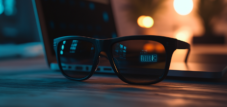Real smart glasses without Augmented & Mixed Reality XR functionality? Ray-Ban Meta Glasses and Solo's AirGo V (Vision)
Xpert pre-release
Language selection 📢
Published on: December 24, 2024 / Update from: December 29, 2024 - Author: Konrad Wolfenstein

Real intelligent glasses still without Augmented & Mixed Reality XR functionality – Ray-Ban Meta Glasses and Solos AirGo V (Vision) – Image: Xpert.Digital
Innovative Smartglasses - The intelligent glasses of the future? What the AirGo V and Ray-Ban Meta Glasses can really do
The development of intelligent glasses that go beyond pure photo and video recordings is constantly progressing. Both Solos with their new AirGo V (Vision) smartglasses and Ray-Ban in collaboration with Meta have launched products that are making waves in wearable technology. Although both glasses are not yet full-fledged augmented reality (AR) or mixed reality (MR) devices, they are a significant step towards a future in which you can expect much more than just audio and camera functions. This comprehensive overview highlights the most important features, differences and similarities between the AirGo V and the Ray-Ban Meta Glasses and at the same time provides an outlook on possible developments.
“Solos AirGo V (Vision)” and “Ray-Ban Meta Glasses” – these two models are currently on everyone’s lips. Consumers and those interested in technology continually ask themselves the questions: What can these glasses actually do? How is AI integration different? And how far are both products from real augmented reality? In order to provide a comprehensive overview, we will first look at the main features and outstanding functions of the two models below.
1. AI integration and assistants
The integration of artificial intelligence is considered by many to be the heart of modern smart glasses, as it enables voice control, personal assistants and other context-related functions. Anyone who buys glasses in the future not only wants a fashionable accessory, but also a practical, intelligent tool for everyday life. This is where both solos and meta come in, but they take different paths.
AirGo V
The “AirGo V (Vision)” smart glasses from Solos focus on the broadest possible selection of AI services. With built-in ChatGPT-4.0 and additional support for multiple AI frameworks such as OpenAI GPT-4, Anthropic's Claude and Google Gemini, the glasses allow users to rely on a specific AI assistant depending on their personal preference and use case. This open platform approach is valued by many technology enthusiasts as it brings greater flexibility and future-proofing.
Solos also points out an adaptive function in which the glasses can independently select the appropriate AI service if the user wishes. This type of intelligent routing is intended to ensure that the best framework is used for each task. For example, if you need quick summaries, you can start the optimal assistant with a simple voice prompt. These options can be a crucial advantage for users who already have experience with various AI assistants or maintain specific preferences.
Ray Ban Meta
In contrast, Ray-Ban and Meta are relying on a more closed solution. “Ray-Ban Meta Glasses” use Meta AI, which is based on the large language model LLaMA 2. The advantage here is the deep integration into the Meta ecosystem, which is particularly interesting for users who already intensively use Meta's services (such as Facebook, Instagram or WhatsApp). Requests, commands and interactions can be seamlessly linked to Meta's platforms. Anyone who wants to be active in social networks directly with glasses will benefit from this integration. However, freedom of choice is lacking: Meta AI is practically the only option when it comes to AI assistants.
The question of which AI approach is better cannot be answered in general terms. Both glasses have their advantages. While the AirGo V scores with its openness, the Ray-Ban Meta Glasses impress with a particularly seamless connection to the major social media platforms.
2. Hardware and design
Smartglasses are both technology products and fashion accessories. Anyone who wants to use such glasses in everyday life pays particular attention to comfort, weight and discretion. Nothing is more annoying than glasses that are too heavy or whose design looks too much like a “high-tech gadget”. Both Solos and Ray-Ban have done their homework here, as both models offer relatively light constructions and are visually based on classic glasses shapes.
AirGo V
According to the manufacturer, the “AirGo V” from Solos only weighs 42 grams. This is a considerable value for smart glasses, as it integrates a camera module, battery, speakers and microphones. To take privacy into account, the camera module is designed to be removable. This means that users can also use the glasses without a camera and therefore have fewer concerns about unnoticed recordings in everyday life. There is also a comparatively powerful battery that should be able to enable around 2,500 AI interactions or photo recordings. This significantly reduces the need for constant charging - an essential factor if you actually want to use a wearable on a daily basis.
Another interesting feature is the interchangeable frame system: If you like to wear glasses in different styles, you can change the frame of the AirGo V without having to change the actual technology. As long as the glasses frames are compatible, you always have the same technical equipment.
Ray Ban Meta
In collaboration with Meta, Ray-Ban has developed a product that is visually closely based on the well-known Wayfarer shape. The weight is around 50 grams, which is only a few grams more than the classic Wayfarer models. This discreet visual appearance is an important plus point for many users, as the glasses do not immediately attract attention as a technology fan.
However, the camera module is permanently installed here, which does not require the camera component to be removed or switched off completely. This can have advantages or disadvantages depending on user needs. For example, if you often want to wear your glasses in environments where photography is undesirable, you will have to rely on software solutions or other methods to ensure that no photos are taken. Ray-Ban emphasizes the long battery life of around three to four hours with intensive use; In addition, an included charging case offers a practical solution for recharging the glasses several times on the go.
3. Features and Benefits
An important differentiator between the two models lies in the specific functions that the manufacturers have integrated. This includes not only camera and voice assistants, but also convenience functions such as translations, fitness tracking and music streaming.
AirGo V
The “AirGo V” places value on the widest possible range of uses. In addition to the versatile AI integration (ChatGPT-4.0, OpenAI GPT-4, Anthropic's Claude and Google Gemini), the real-time translation function (SolosTranslate) is particularly noteworthy. Anyone who is often confronted with foreign language texts in everyday life or when traveling can receive translations directly via their glasses. It proves to be advantageous that SolosTranslate can access various AI models in order to deliver precise results.
Additionally, Solos integrates fitness tracking features. If you want to keep an eye on your vital signs while jogging, cycling or in the gym, you can do this directly via your glasses. According to the manufacturer, it relies on simple but reliable sensors that record basic health and activity data. Another highlight is the high battery performance, which should enable up to 2,500 AI interactions or photos per charge. In addition, around 10 hours of music streaming or 7 hours of telephony are specified, which is quite suitable for everyday use for many users.
Ray Ban Meta
The “Ray-Ban Meta Glasses” focus on interaction with social media. “Live streaming capabilities for Facebook and Instagram” are advertised, allowing users to share their surroundings or experiences with their community in real time. There is also an integrated reminder function that automatically links photos with notes or voice recordings. This allows you to capture spontaneous impressions without having to pull out your smartphone.
Another interesting feature is support for music services such as Spotify and Amazon Music. You can use your voice command to start playlists, change songs or adjust the volume without having to take your cell phone out of your pocket. For everyday users who often spend time in Meta's social media world, this creates a completely connected experience.
4. Price and Availability
In terms of price, both glasses are at a similar level. Solos is offering the AirGo V for 290 euros or $299, with delivery scheduled for December 23, 2024. The Ray-Ban Meta Glasses are already available and start at $299 in the US, although higher prices may apply depending on the version. Users have to weigh up whether they think the advantages of Solos' open AI platform are interesting or whether they would rather go straight to the Ray-Ban Meta to take advantage of the intensive meta integration.
5. Special functions in direct comparison
A direct comparison often brings to light aspects that are lost in pure manufacturer information.
Openness vs. ecosystem
“AirGo V” stands for the open platform approach, while the “Ray-Ban Meta” impresses with its strong connection to the meta universe.
Removable camera module vs. permanently installed
Anyone who values data protection or discreet use will appreciate the AirGo V's removable camera module. The Ray-Ban Meta, on the other hand, impresses with its chic, slim design, which does not allow the camera to be removed.
Translation vs. social media
With “SolosTranslate” and fitness functions, the AirGo V positions itself as an everyday companion for travel, sports and general productivity. The Ray-Ban Meta focuses on streaming and social networks - a perfect choice for influencers and users who like to share content in real time.
Weight vs Style
42 grams of the AirGo V versus around 50 grams of the Ray-Ban Meta - both glasses are comparatively light. The Ray-Ban design has the advantage of being iconic for many, while Solos relies primarily on technical refinements and an interchangeable frame system for its glasses.
6. How far are they from true AR/MR?
Although Solos and Ray-Ban emphasize progressiveness in their marketing campaigns, both models are not yet comparable to real augmented reality or mixed reality headsets. This is particularly evident in the lack of visual projection of information into the user's field of vision.
Missing displays and overlays
Neither the AirGo V nor the Ray-Ban Meta Glasses have their own display that projects digital elements into the field of vision. Functions such as route instructions that are placed directly on the road or interactive games in the real environment are therefore not possible. Anyone who wants to experience such functions currently has to wait for specialized headsets such as certain XReal models or other next-generation AR glasses.
Technology and energy requirements
AR/MR glasses that project real overlays in real time require advanced sensors, powerful processors and high quality displays. This requires significantly more energy than the comparatively “simple” camera and audio functions of current smart glasses consume. The form factor also suffers with complete AR glasses: you need space for projectors, batteries and processors. This makes the glasses heavier, larger and more noticeable.
Gradual development
“We are moving in small steps towards AR and MR,” could be the conclusion. The current smart glasses serve more as a link between classic glasses and highly developed AR headsets. They are a viable solution for people who want more convenience functions and AI interactions in a form factor that is still suitable for everyday use, but can still do without a visual display.
It is almost certain that both Solos and Meta will develop further generations of these glasses in the future. These could then gradually integrate more AR functions as the technology becomes more mature and lighter, more energy-efficient components become available.
7. Outlook and future opportunities
The “AirGo V” and the “Ray-Ban Meta Glasses” are currently neither equipped with holograms nor complex 3D environments, but they clearly show how wearable technology can gain a foothold in everyday life. Whether you rely on an open platform with several AI frameworks or a closely interlinked integration into social networks - in both cases numerous areas of daily life can be simplified:
- Navigation: Future versions could display simple visual instructions in the field of vision.
- Advanced Voice Control: Both ChatGPT-4.0 and Meta AI are evolving to make conversations more natural and better recognize contextual information.
- Health and fitness functions: The recording of vital data could be expanded, e.g. B. by integrating pulse sensors in the nose bridge or by evaluating eye movements for stress measurements.
- Hand and gesture control: Real AR glasses often rely on gesture recognition. This technology could also one day be established in smart glasses to enable commands without voice input.
- Adaptive displays: There is still a lack of suitable technologies that can be integrated invisibly into the frame, but prototypes already exist. An inconspicuous projector that projects information onto the inside of the lens could soon be a reality.
With each new hardware generation, the components become smaller. Microdisplays are becoming sharper and using less energy, processors are becoming more powerful and software frameworks are becoming more intelligent. So it's very likely that in the coming years we'll see smartglasses that move ever closer to true AR functionality.
8. We are only at the beginning
The “Solos AirGo V (Vision) Smartglasses” and the “Ray-Ban Meta Glasses” are two exciting products that show what possibilities can already be achieved in the area of smart glasses today. Both models offer a combination of camera, audio functions and AI support, but differ primarily in their depth of integration and openness.
- AirGo V: “More open platform” could be the leitmotif here. The glasses impress with broad AI compatibility, a practical real-time translation function, fitness tracking and the ability to remove the camera module. At 42 grams, it is pleasantly light, and the battery promises a surprisingly long runtime.
- Ray-Ban Meta: If you are already in the meta universe and are looking for a simple but elegant option for live streaming on Facebook or Instagram, you might find what you are looking for here. The glasses score points with their well-known, fashionable wayfarer design and a strong social media connection. Meta AI, based on LLaMA 2, offers a solid voice assistant solution, but without the freedom of choice of other AI frameworks.
Both glasses are still a long way from providing true AR experiences with visual overlays or 3D object detection. However, they ensure a smooth transition between classic glasses and future mixed reality devices. Anyone who already wants to benefit from AI functions and take photos or videos directly using the glasses will enjoy both products. Whether you value more freedom in choosing your assistant or prefer seamless social networking is ultimately a matter of taste.
“We are only at the beginning,” one might say when looking into the future of smart glasses and AR technologies. The industry is learning quickly, components are becoming smaller and software is becoming smarter. More models that move towards true augmented reality will come onto the market in the near future. With glasses already available today that seamlessly support ChatGPT-4.0 or Meta AI, it's easy to imagine how powerful future generations will be once advanced displays and tracking capabilities are added.
“Solos AirGo V (Vision)” and “Ray-Ban Meta Glasses” differ in their technical implementation and orientation, but at the same time both build a bridge to a future generation of AR/MR glasses. They meet the needs of many users who are looking for smart functions, AI integration, convenient audio features and an attractive design. Whether and when they will catch up in terms of immersive visual technology remains to be seen. Until then, you can enjoy practical solutions such as real-time translation, fitness tracking, live streaming and intuitive voice control and follow technological progress step by step.
🎯🎯🎯 Benefit from Xpert.Digital's extensive, fivefold expertise in a comprehensive service package | R&D, XR, PR & SEM

AI & XR 3D Rendering Machine: Fivefold expertise from Xpert.Digital in a comprehensive service package, R&D XR, PR & SEM - Image: Xpert.Digital
Xpert.Digital has in-depth knowledge of various industries. This allows us to develop tailor-made strategies that are tailored precisely to the requirements and challenges of your specific market segment. By continually analyzing market trends and following industry developments, we can act with foresight and offer innovative solutions. Through the combination of experience and knowledge, we generate added value and give our customers a decisive competitive advantage.
More about it here:
We are there for you - advice - planning - implementation - project management
☑️ SME support in strategy, consulting, planning and implementation
☑️ Creation or realignment of the digital strategy and digitalization
☑️ Expansion and optimization of international sales processes
☑️ Global & Digital B2B trading platforms
☑️ Pioneer Business Development
I would be happy to serve as your personal advisor.
You can contact me by filling out the contact form below or simply call me on +49 89 89 674 804 (Munich) .
I'm looking forward to our joint project.
Xpert.Digital - Konrad Wolfenstein
Xpert.Digital is a hub for industry with a focus on digitalization, mechanical engineering, logistics/intralogistics and photovoltaics.
With our 360° business development solution, we support well-known companies from new business to after sales.
Market intelligence, smarketing, marketing automation, content development, PR, mail campaigns, personalized social media and lead nurturing are part of our digital tools.
You can find out more at: www.xpert.digital - www.xpert.solar - www.xpert.plus























